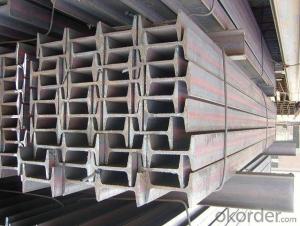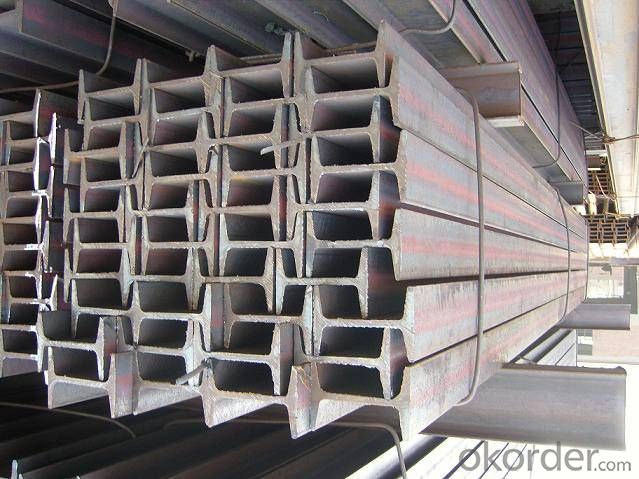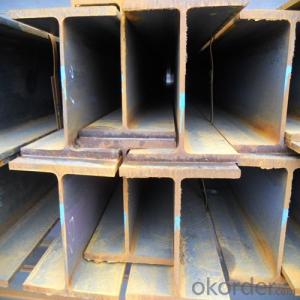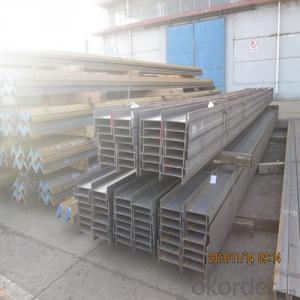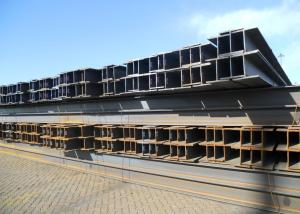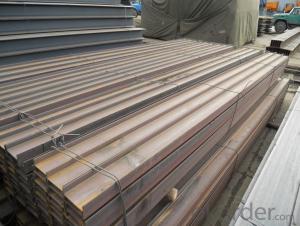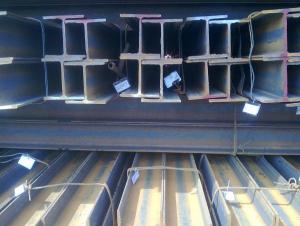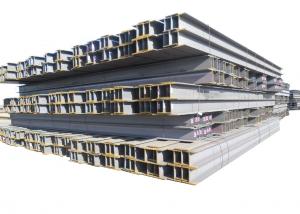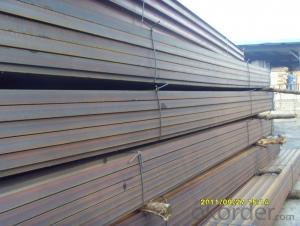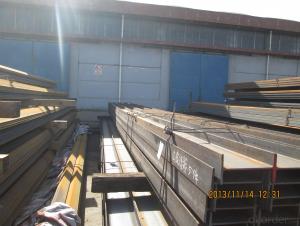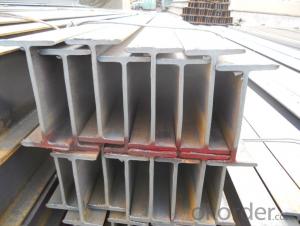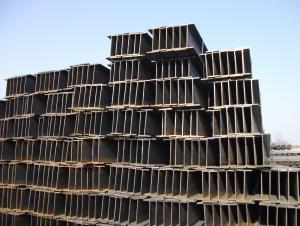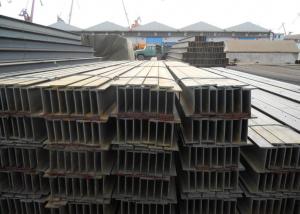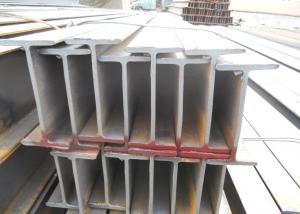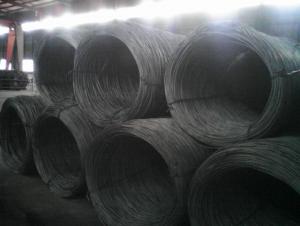175*90mm hot sell h beam for construction
- Loading Port:
- Tianjin
- Payment Terms:
- TT or LC
- Min Order Qty:
- 25 m.t.
- Supply Capability:
- 100000 m.t./month
OKorder Service Pledge
OKorder Financial Service
You Might Also Like
Secifications of Hot Rolled Steel H-beam
1. Standard: JIS 3192
2. Grade: SS400 or Equivalent
3. Length: 10m, 12m as following table
4. Invoicing on theoretical weight or actual weight as customer request
5.Payment: TT or L/C
Packaging & Delivery of Hot Rolled H-Beam Steel for Building Structures
1. Packing: it is nude packed in bundles by steel wire rod
2. Bundle weight: not more than 3.5MT for bulk vessel; less than 3 MT for container load
3. Marks:
Color marking: There will be color marking on both end of the bundle for the cargo delivered by bulk vessel. That makes it easily to distinguish at the destination port.
Tag mark: there will be tag mark tied up on the bundles. The information usually including supplier logo and name, product name, made in China, shipping marks and other information request by the customer.
If loading by container the marking is not needed, but we will prepare it as customer request.
4. Transportation: the goods are delivered by truck from mill to loading port, the maximum quantity can be loaded is around 40MTs by each truck. If the order quantity cannot reach the full truck loaded, the transportation cost per ton will be little higher than full load.
5. Delivered by container or bulk vessel
* If you would like to get our price, please inform us the size, standard/material and quantity. Thank you very much for your attention
Function Structure
Light H-beam has been widely applied as building material and has a very good market prospect. High frequency H-beam welding is a new technology for H-beam welding with the advantages of energy-saving, high efficiency and convenient operation etc.
H-beam welding equipment adopts two sets 300kW or 600kW solid state high frequency welder with exactly the same model. One welds web plate and upper flange plate, the other welds web plate and lower flange plate. The welding mode is contact welding. Solid state high frequency welder adopts AC-DC-AC frequency conversion structure. The rectifier adopts 3-phase thyristor. The inverter adopts high voltage large power MOSFET to form full bridge resonance inversion. Inverter output adopts high efficiency ferrite matching transformer to finish power combination, impedance matching and electrical isolation. Resonance tank circuit adopts two sides serial resonance.
The complete unit of equipment is composed of switchgear rectifying cabinet, inverter output cabinet, contact head mechanism, circulation soft water cooling system, console and 3-D positioning table.
Technical Features
Ø Perfect structure design
1.Independent design of switchgear rectifying cabinet and inverter output cabinet, connected by soft cable, which is convenient for layout at user’s site.
2.Power combination of the inverter bridge is accomplished by the way of power unit superposition. Each MOSFET power unit is designed to be 100kW and slideway drawer structure, which is convenient for installation and repair.
3.3-D positioning table is adopted for both of the two sets contact type welder. Contact head adopts pressure control, which has a good synchronism and consistency.
4.High standard electromagnetism compatibility design, electromagnetism radiation meets national standard.
5.Closed cabinet design, meeting rigor environmental requirements on site.
Ø Full-digital Synchronization Control System
1. 3-phase rectifier adopts high cost performance MCU controlling to realize precise synchronism trigger with high control precision and small grid-side non characteristic harmonic.
2. Resonant inverter adopts CPLD to form full-digital control system that is characterized by their automatic constant angle, high phase-lock precise and wide scope of phase-lock.
3. The two sets solid state high frequency welder has the function of synchronization control with the features of stable working and small interference.
4.The welder has perfect protection function with reliable working and low failure rate.
Ø HMI and fault diagnosis system
1. Adopt PLC and touch screen to form perfect HMI system.
2. Realize integrated automatic control of welder system.
3. Fault display and diagnosis system.
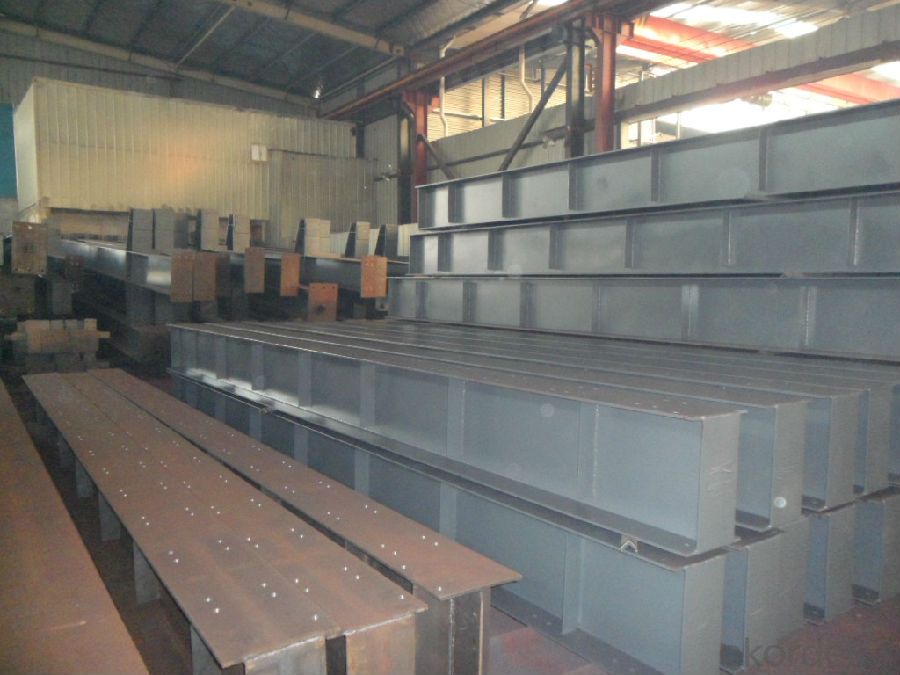

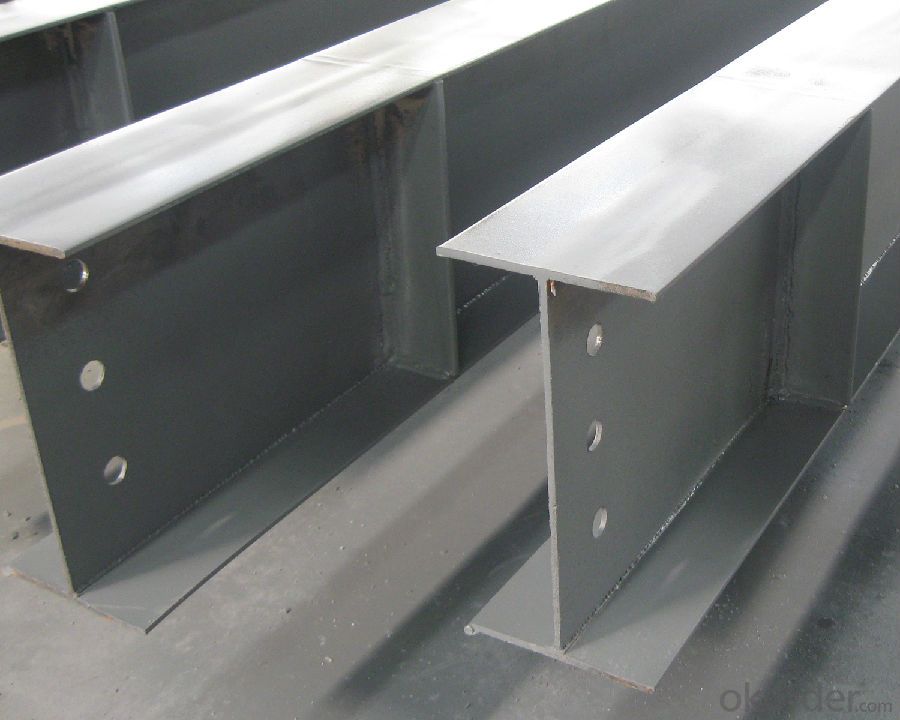
- Q: Are there any maintenance requirements for Steel H-Beams?
- Steel H-Beams require maintenance to ensure their structural integrity remains intact. Despite being a highly durable material, steel is still susceptible to various factors that can impact its stability over time. Here are some maintenance requirements to consider: 1. Conduct Regular Inspections: It is crucial to have qualified professionals regularly inspect the steel H-beams for any signs of damage, corrosion, or deformations. These inspections will help determine if any maintenance or repairs are needed. 2. Keep them Clean: Regular cleaning is necessary to remove dirt, dust, and debris that may accumulate on the surface of the steel beams. Use a mild detergent or specialized steel cleaner, followed by rinsing with water. Avoid abrasive materials or harsh chemicals that could damage the protective coating. 3. Prevent Corrosion: Steel H-beams are prone to corrosion, especially in humid or coastal environments. To prevent this, apply a protective coating or paint to act as a barrier against moisture and corrosive elements. Regularly inspect the coating for damage and touch up as needed. 4. Address Structural Issues: If any structural problems are identified during inspections, such as cracks, bends, or excessive deflection, immediate repairs should be carried out. Depending on the severity, repairs may involve reinforcing, welding, or replacing sections. It is essential to involve experienced engineers or contractors in steel structures for these repairs. 5. Monitor Load: Steel H-beams have specific load capacities. It is crucial to monitor and ensure that the applied loads do not exceed their design limits. Overloading can lead to structural failures or premature deterioration. Regularly assess the loads and consult professionals to ensure proper weight distribution and prevent potential issues. By adhering to these maintenance requirements, steel H-beams can maintain their structural integrity and longevity. Consult experts in steel structures or engineers for project-specific guidance.
- Q: Can steel H-beams be used for wastewater treatment plants?
- Yes, steel H-beams can be used for wastewater treatment plants. Steel H-beams are commonly used in construction due to their strength and durability. In wastewater treatment plants, they can be utilized for various purposes such as supporting heavy equipment and structures, providing structural support for tanks and basins, and constructing walkways and platforms. The strength of steel H-beams allows them to withstand the harsh conditions and corrosive nature of wastewater treatment plants, making them a suitable choice for this application. Additionally, steel H-beams can be easily fabricated and customized to meet specific design requirements, making them versatile for a variety of wastewater treatment plant applications.
- Q: Can steel H-beams be used for temporary structures?
- Indeed, temporary structures can indeed employ steel H-beams. Due to their robustness and endurance, steel H-beams are frequently utilized in the realm of construction. With the capability to endure substantial loads and offer structural reinforcement, they are well-suited for temporary structures including scaffolding, temporary bridges, and event stages. The adaptability and simplicity of assembling steel H-beams render them an exemplary selection for swiftly constructing and dismantling temporary structures. Furthermore, the transportation and reuse of steel H-beams for various projects is effortlessly achievable, rendering them a financially viable choice for temporary structures.
- Q: Are steel H-beams compatible with other construction materials?
- Indeed, other construction materials are compatible with steel H-beams. Given their exceptional strength-to-weight ratio, durability, and versatility, steel H-beams are widely used in construction. They can be seamlessly incorporated with various materials, including concrete, wood, and other metals. For example, when combined with concrete slabs or wooden beams, steel H-beams serve as reliable structural support, ensuring the creation of robust and stable frameworks for buildings or bridges. Furthermore, through welding or bolting, steel H-beams can be joined with other steel components, enabling the construction of intricate structures. Overall, steel H-beams display remarkable compatibility with other construction materials, making them an advantageous choice for a diverse array of construction projects.
- Q: How do steel H-beams perform in earthquake-prone regions?
- Steel H-beams are widely regarded as one of the most effective structural elements in earthquake-prone regions. The unique shape and composition of H-beams make them highly resistant to seismic forces, ensuring better performance during earthquakes compared to other building materials. Firstly, the H shape of these beams provides excellent strength and load-bearing capacity. The design distributes the weight evenly along the length of the beam, enabling it to withstand the lateral forces generated by earthquakes. This feature allows H-beams to resist bending and deformation, which is crucial for maintaining the structural integrity of a building during seismic events. Additionally, steel itself is a highly durable and flexible material. It exhibits exceptional tensile strength, allowing it to stretch and absorb the energy generated during an earthquake. This characteristic prevents the beams from fracturing or collapsing under the intense shaking and ground motion experienced in earthquake-prone regions. Moreover, steel H-beams can be fabricated with specific seismic design principles in mind. Engineers can incorporate strategies such as moment-resisting frames or base isolation systems, which further enhance the seismic performance of these beams. These design techniques help dissipate and redirect seismic forces away from the building, reducing the potential for structural damage. Furthermore, steel H-beams offer advantages in terms of construction speed and versatility. They can be prefabricated offsite and easily assembled on-site, saving time and resources during construction. This flexibility also allows for the creation of complex building designs, which can be crucial in areas with limited space or unique architectural requirements. In conclusion, steel H-beams are highly suitable for earthquake-prone regions due to their exceptional strength, flexibility, and adaptability. Their unique shape, material properties, and the ability to incorporate seismic design principles make them a reliable choice for ensuring the safety and resilience of structures in areas susceptible to seismic activity.
- Q: How do steel H-beams perform in areas with high humidity and saltwater exposure?
- When steel H-beams are exposed to high humidity and saltwater, they may corrode and weaken over time. However, their performance can be improved by properly protecting them against corrosion. One way to achieve this is by applying protective finishes or galvanizing the steel H-beams. These coatings create a barrier between the steel and the corrosive elements, minimizing the risk of rust formation. It is important to regularly inspect and maintain the steel H-beams to promptly identify and address any damage or deterioration. By taking these precautions, the steel H-beams can endure high humidity and saltwater exposure reliably and durably.
- Q: How are steel H-beams connected or joined together in construction?
- Steel H-beams, also known as I-beams, are commonly used in construction due to their strength and load-bearing capabilities. These beams are connected or joined together using various methods, depending on the specific construction project and requirements. One of the most common methods for joining steel H-beams is through welding. Welding involves heating the two beams at the connection point and then fusing them together using a welding electrode. This creates a strong and permanent bond between the beams. Welding is widely used in construction as it provides a reliable and sturdy connection, ensuring the structural integrity of the building. Another method used to connect steel H-beams is through bolting. Bolting involves using bolts, nuts, and washers to secure the beams together at the connection point. Holes are drilled through the beams, and bolts are inserted and tightened using a wrench or spanner. Bolting is a popular method as it allows for easy disassembly and reassembly, making it suitable for projects that may require modifications or relocation in the future. In some cases, steel H-beams may also be connected using rivets. Riveting involves drilling holes through both beams and then inserting rivets, which are cylindrical metal pins. The rivets are then hammered or compressed to secure the beams together. Although riveting was widely used in the past, it is less common in modern construction due to the time-consuming nature of the process. However, it can still be employed in specific situations where the aesthetic appeal or historical significance of riveted connections is desired. Lastly, adhesive bonding can also be used to connect steel H-beams. This method involves applying a strong adhesive or epoxy to the connection point and then pressing the beams together. Adhesive bonding is advantageous as it provides a clean and visually appealing connection, without the need for visible welds or bolts. However, it is less commonly used in construction due to the potential challenges in achieving a reliable and long-lasting bond. Overall, steel H-beams can be connected or joined together in construction through methods such as welding, bolting, riveting, or adhesive bonding. The choice of joining method depends on the specific project requirements, structural considerations, and aesthetic preferences.
- Q: Can steel H-beams be used for shopping centers?
- Yes, steel H-beams can be used for shopping centers. Steel H-beams are commonly used in commercial construction, including shopping centers, due to their strength, durability, and ability to support heavy loads.
- Q: What are the different types of steel H-beam connections for seismic-resistant buildings?
- There are several different types of steel H-beam connections that can be used in seismic-resistant buildings. These connections are specifically designed to withstand the forces and vibrations experienced during earthquakes, ensuring the structural integrity of the building. Some of the commonly used types of steel H-beam connections for seismic-resistant buildings include: 1. Welded connections: This is the most common type of connection used in seismic-resistant buildings. Welded connections involve joining the H-beams together using various welding techniques such as fillet welds or groove welds. Welded connections provide excellent strength and stiffness, making them suitable for seismic applications. 2. Bolted connections: Bolted connections involve using bolts and nuts to join the H-beams together. These connections offer ease of installation and flexibility for future modifications or repairs. However, they may not provide the same level of stiffness as welded connections. 3. Moment connections: Moment connections are designed to transfer both vertical and horizontal forces between H-beams while allowing rotational movement. This type of connection is commonly used in beam-to-column joints and provides enhanced resistance against seismic forces by allowing controlled plastic deformation. 4. Shear connections: Shear connections are used to transfer vertical loads between H-beams. These connections are designed to resist shearing forces and prevent the beams from sliding relative to each other. Shear connections are essential for maintaining the stability of the structure during seismic events. 5. Composite connections: Composite connections involve combining steel H-beams with other materials such as concrete or timber. These connections offer enhanced strength, stiffness, and ductility, making them suitable for seismic-resistant buildings. 6. Moment-resisting connections: Moment-resisting connections, also known as rigid connections, provide high resistance against lateral forces. These connections are designed to maintain rigidity and prevent rotation between H-beams and other structural elements, ensuring the building remains stable during seismic events. It is essential to consult with structural engineers and adhere to local building codes and regulations when selecting and designing steel H-beam connections for seismic-resistant buildings. The specific type of connection used will depend on factors such as the building design, anticipated seismic forces, and desired level of performance.
- Q: What are the different grades of steel used in H-beams?
- H-beams in the manufacturing industry commonly employ different grades of steel. The selection of steel grade relies on the desired strength and durability of the H-beam, as well as the intended application. A few frequently used grades encompass A36, A572, A588, A992, and A913. A36 steel, widely utilized, boasts exceptional strength and formability. This grade is often employed in construction projects necessitating a high strength-to-weight ratio. A572 steel, another favored grade, is renowned for its remarkable strength and weldability. It finds common use in structural applications like bridges, buildings, and heavy machinery. A588 steel is categorized as a weathering grade, gradually developing a protective rust-like appearance. This characteristic proves advantageous for outdoor applications exposed to harsh weather conditions, such as bridges and buildings. A992 steel enjoys widespread usage in H-beams due to its impressive strength and mechanical properties. Industrial and commercial structures, including warehouses, factories, and high-rise buildings, often utilize this grade. A913 steel, a high-strength low-alloy (HSLA) grade, offers exceptional yield strength and toughness. It is frequently employed in high-stress applications where weight reduction and durability play vital roles, especially in bridge construction. These examples represent only a fraction of the steel grades available for H-beams. The selection of grade hinges on project-specific requirements, encompassing load-bearing capacity, environmental conditions, and overall structural design.
Send your message to us
175*90mm hot sell h beam for construction
- Loading Port:
- Tianjin
- Payment Terms:
- TT or LC
- Min Order Qty:
- 25 m.t.
- Supply Capability:
- 100000 m.t./month
OKorder Service Pledge
OKorder Financial Service
Similar products
Hot products
Hot Searches
Related keywords
